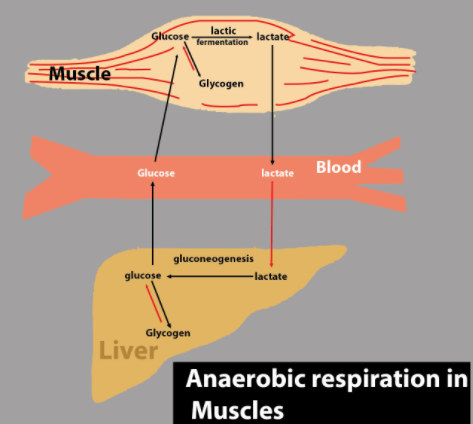
Which of the following is the byproduct of anaerobic respiration in muscles?
(A)Sugar
(B)Lactic acid
(C)HCl
(D)Oxygen
Answer
566.4k+ views
Hint: The byproduct of anaerobic respiration in muscles is an organic acid that is white in solid-state and has a molar mass of 90g/mol. When this bi-product is released, it becomes harder to exercise more.
Complete answer:
the byproduct of anaerobic respiration in muscles is Lactic acid. During anaerobic respiration, your muscle cells use sugar to form ATP, but they do not use oxygen. This process produces lactate, which in a very short time gets converted to lactic acid, which makes your muscles burn. lactic acid, as you'll have experienced, makes it harder to exercise.
Additional Information: Most organisms need oxygen for respiration but in some organisms and even in some tissues can still respire if the oxygen runs out. In conditions when there is low or no oxygen, the method of anaerobic respiration occurs. The 'an' in 'anaerobic' means without. In anaerobic respiration, during the oxidation of glucose not all of the energy will be released from the glucose molecule because it is just partially broken down. This means the oxidation of glucose is incomplete. This is the reason, the reaction releases much less energy than aerobic respiration - This implies that fewer molecules of ATP are often made.
So, the correct answer is ‘Lactic acid’.
Note: The lactic acid production depends mainly on two different factors which are cellular ph and temperature. Lactic acid produced during anaerobic respiration lowers the cellular pH and a lower pH means it will be harder to make ATP, which is needed for muscle contraction. When our muscles are cold, they have a much harder time contracting and the lactic acid is present in larger amounts.

Complete answer:
the byproduct of anaerobic respiration in muscles is Lactic acid. During anaerobic respiration, your muscle cells use sugar to form ATP, but they do not use oxygen. This process produces lactate, which in a very short time gets converted to lactic acid, which makes your muscles burn. lactic acid, as you'll have experienced, makes it harder to exercise.
Additional Information: Most organisms need oxygen for respiration but in some organisms and even in some tissues can still respire if the oxygen runs out. In conditions when there is low or no oxygen, the method of anaerobic respiration occurs. The 'an' in 'anaerobic' means without. In anaerobic respiration, during the oxidation of glucose not all of the energy will be released from the glucose molecule because it is just partially broken down. This means the oxidation of glucose is incomplete. This is the reason, the reaction releases much less energy than aerobic respiration - This implies that fewer molecules of ATP are often made.
So, the correct answer is ‘Lactic acid’.
Note: The lactic acid production depends mainly on two different factors which are cellular ph and temperature. Lactic acid produced during anaerobic respiration lowers the cellular pH and a lower pH means it will be harder to make ATP, which is needed for muscle contraction. When our muscles are cold, they have a much harder time contracting and the lactic acid is present in larger amounts.

Recently Updated Pages
Why are manures considered better than fertilizers class 11 biology CBSE

Find the coordinates of the midpoint of the line segment class 11 maths CBSE

Distinguish between static friction limiting friction class 11 physics CBSE

The Chairman of the constituent Assembly was A Jawaharlal class 11 social science CBSE

The first National Commission on Labour NCL submitted class 11 social science CBSE

Number of all subshell of n + l 7 is A 4 B 5 C 6 D class 11 chemistry CBSE

Trending doubts
10 examples of friction in our daily life

One Metric ton is equal to kg A 10000 B 1000 C 100 class 11 physics CBSE

Difference Between Prokaryotic Cells and Eukaryotic Cells

1 Quintal is equal to a 110 kg b 10 kg c 100kg d 1000 class 11 physics CBSE

State the laws of reflection of light

Explain zero factorial class 11 maths CBSE




